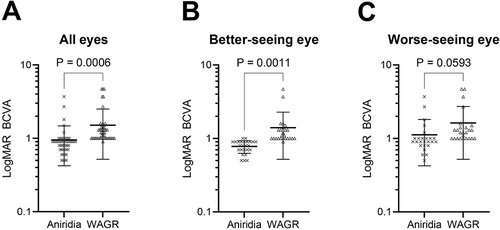Figures & data
Table 1 Characteristics of Aniridia and WAGR Spectrum Subjects
Table 2 Visual Acuity in Aniridia and WAGR Spectrum Subjects
Figure 1 Scatter plots for LogMAR values in aniridia and WAGR spectrum subjects. (A) Values for both eyes in aniridia (N=50) and WAGR spectrum (N=50) subjects. (B) Values for the better-seeing eye in aniridia (N=25) and WAGR spectrum (N=25) subjects. (C) Values for the worse-seeing eye in aniridia (N=25) and WAGR spectrum (N=25) subjects. Heavy horizontal lines indicate the mean and lighter horizontal lines indicate the standard deviation for each group. The analyses of all eyes and better-seeing eyes comparing aniridia and WAGR spectrum subjects were statistically significantly different in both analyses.

Table 3 Average Visual Function Thresholds in Aniridia and WAGR Spectrum Subjects
